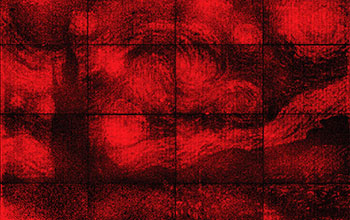Multimedia Gallery
DNA origami lights up a microscopic glowing Van Gogh
A microscopic reproduction--the width of a dime across--of Van Gogh's "The Starry Night" recreated on a silicon nitride chip. Each of the 65,536 pixels is a bacterium-sized light source into which a different number of red fluorescent molecules has been loaded.
More about this image
Researchers at Caltech used folded DNA to precisely place glowing molecules within microscopic light resonators to create one of the world's smallest reproductions of Vincent van Gogh's "The Starry Night."
Light sources like these might be used to power optical computers on a chip but it's the technology underlying their fabrication that is most exciting. A combination of self-folding DNA origami and the sort of printing process used to make computer chips is used to determine the number and exact position of glowing molecules. Putting molecules exactly where we want them on computer chips has been hard, and this new technology makes it possible to combine molecular devices with computer chips, which may enable applications from quantum computers to sensitive diagnostics.
The research was supported in part by the National Science Foundation (grants CCF 08-32824 and CCF 13-17694).
To learn more about this research, see the Caltech news story DNA Origami Lights Up a Microscopic Glowing Van Gogh. (Date image taken: May 2015; date originally posted to NSF Multimedia Gallery: Oct. 4, 2016)
Credit: Ashwin Gopinath, Caltech
See other images like this on your iPhone or iPad download NSF Science Zone on the Apple App Store.
Special Restrictions: When reproducing this image you must contact the copyright holder, Ashwin Gopinath, at ashwing@caltech.edu to state your intentions.
Images and other media in the National Science Foundation Multimedia Gallery are available for use in print and electronic material by NSF employees, members of the media, university staff, teachers and the general public. All media in the gallery are intended for personal, educational and nonprofit/non-commercial use only.
Images credited to the National Science Foundation, a federal agency, are in the public domain. The images were created by employees of the United States Government as part of their official duties or prepared by contractors as "works for hire" for NSF. You may freely use NSF-credited images and, at your discretion, credit NSF with a "Courtesy: National Science Foundation" notation.
Additional information about general usage can be found in Conditions.
Also Available:
Download the high-resolution JPG version of the image. (2.9 MB)
Use your mouse to right-click (Mac users may need to Ctrl-click) the link above and choose the option that will save the file or target to your computer.

